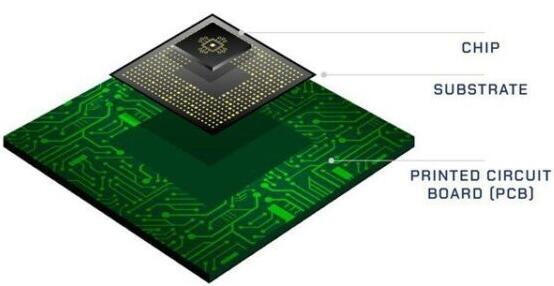IC substrate refers to the carrier on an integrated circuit chip. It is composed of multiple layers of composite materials, which can provide circuit connections and temporary storage functions.

The IC substrate is usually composed of copper foil, glass fiber layer, and substrate layer. Its design and manufacturing process is relatively complex, requiring customization based on specific IC chips. The IC substrate plays a crucial role in connecting IC chips and other electronic components in electronic devices and is a crucial component for the normal operation of electronic devices.
PCB is a circuit carrier widely used in electronic products. PCB is used to connect and support electronic components and is an important component in electronic devices. It adopts a process of printing circuits using conductive materials and isolating circuits using non-conductive materials. The commonly used materials for PCBs include glass fiber, epoxy resin, and copper foil. PCB has high strength, good conductivity, and isolation performance. Its design and manufacturing process is relatively simple, and it can be mass-produced.
The difference between IC substrate and PCB
1. Definition
PCB is the support body of electronic components and the carrier for the electrical interconnection of electronic components.
IC substrate is an integrated circuit chip carrier used to install integrated circuit chips and provide electrical connections with extremely high density and reliability.
2. Materials
PCB uses conductive and insulating materials such as copper-clad board, fiberglass material, and PTFE material.
The IC substrate mainly uses polymer materials and brittle ceramic materials.
3. Structure
A PCB is formed by stacking multiple layers of boards, which can be connected through holes.
The structure of the IC substrate mainly includes the circuit layer and the assembly layer.
4. Manufacturing process
PCB manufacturing includes steps such as design, graphic layout, SMT, soldering, and testing.
The IC substrate needs to undergo processes such as preheating, drilling pits, and adding buttons.
5. Scenario application
PCB is widely used in the field of electronic product manufacturing, such as computer motherboards, mobile phone circuit boards, etc.
IC substrates have the characteristics of small size, high density, and high reliability, and are widely used in high-end electronic fields, such as aviation and aerospace, national defense and military industry, automotive electronics, etc.
The difference between IC substrates and PCBs lies in their different functions and application areas. The IC substrate is mainly used for the connection and temporary storage of integrated circuit chips and is suitable for some electronic devices that require high performance and customization. PCB is suitable for most electronic devices, used to connect and support various electronic components, and is the most common circuit carrier in electronic devices.
Although IC substrates and PCBs have different functions and application areas, they also have many similarities. Firstly, they are all crucial components of electronic devices, and without them, modern electronic devices would not be able to function properly. Secondly, they all require precise design and manufacturing processes to ensure the stability and reliability of circuit connections. In addition, they can also be customized and mass-produced according to specific needs.